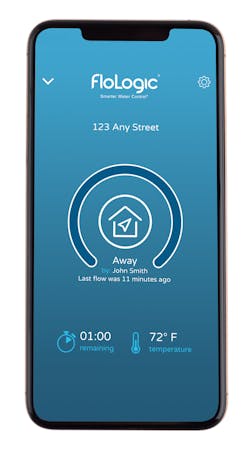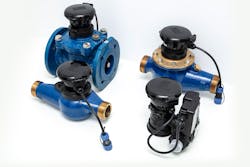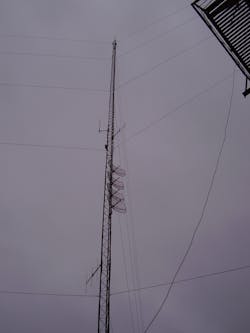Let’s start with some big numbers. First (and maybe most important): one trillion gallons. That’s how much water is lost to leaks each year nationwide, according to the US EPA. That’s equal to the annual household water use of 11 million homes. The average US household leaks roughly 10,000 gallons of water a year—enough to do 270 loads of laundry.
Water is a limited resource, and water costs money, so bad enough it’s being wasted. But catastrophic leaks can also cause serious property damage. According to insurance industry research conducted by Water Damage Defense, a NY-based water damage prevention company (www.waterdamagedefense.com), 14,000 people in the US experience a water damage emergency at home or at work each day.
The annual cost to insurance companies for water damage—when you include mold—is $13 billion a year according to the Insurance Information Institute. Traveler’s Insurance (www.travelers.com) estimates non-weather-related water damage, including plumbing, sewer, and appliance leaks, accounted for 23% of all homeowner claims (with weather-related water accounting for only 12%).
It’s a big problem, and it scales; according to the size of the building; according to the number of buildings and businesses in a municipality. And as shortages make water a more expensive, more tightly controlled commodity, the cost involved around leaks will only increase.
Luckily, new technology is allowing new approaches to rapidly identifying and controlling leaks. Here are three systems working at different scales: the residential/light commercial, enterprise and municipal.
Residential/Light Commercial–FloLogic
The key to the system is the flow sensor, which can monitor and recognize virtually any flow event. “We can see water flow as low as half an ounce per minute,” says Ian Greene, Marketing Director for FloLogic. “We’re not using metering technology, so that doesn’t give us the opportunity to tell a user how much water they’ve used in a day, but on the plus side it allows us to see water flow at much lower levels in real time… systems based on ultrasonic or the little turbine using the Hall Effect requires a much higher threshold. That’s why they do the shut-offs and pressure decay tests in the middle of the night.”
Because the system is monitoring flow, it reaches its limit in applications where water is used almost constantly (such as industrial application, or large office buildings). “It’s more ideal for smaller commercial settings… and certainly any residential home, it’s going to cover that because you’re only going to have the typical water use; showers, toilets, and so on,” says Greene.
“In a typical home there’s a certain amount of [flow] that’s normal, and there’s a certain amount that’s not normal to be used, depending on whether you’re at home or away,” Greene explains. “So we have settings that a homeowner sets based on what’s normal for them and what’s not. For example, the default settings for our system is 30 minutes of allowance in the home mode, and then 30 seconds in the away mode. We find that actually works for most households because most people take a 10 minute shower.
"Through device-specific connections, systems like irrigation, water softeners and pools communicate with FloLogic, telling it to allow long flow events, which is more exacting than AI, while creating a smart plumbing ecosystem."
While the system has its limits, the trade-off is in ease of installation and of use. “It’s really just a valve that you’re putting into the pipe,” Greene says, “so every plumber has the skills to do that installation. The technology side is simple because they come pre-programmed, which will work in most homes.”
Setting up the app is easy enough for the plumber to leave it to the property owner.
FloLogic is seeing more and more incentives from insurance companies to install some form of leak detection, typically in the form of premium discounts. So some homeowners are seeking out the system on their own. But more and more, plumbers are offering it to their customers, either in the wake of an emergency call, or as an upsell during something like a new water heater installation.
“They’re saying, ‘Let me not just fix this leak, but let me make sure it doesn’t happen again,’” Greene says. “It helps to create lifetime customer value… you’re going to catch the leaks, you’re going to catch the toilets running—and not every customer wants to replace their own toilet flapper.”
It gives plumbers, Greeene says, the opportunity to do what the HVAC industry has already done well: to be proactive with customers, rather than reactive.
Enterprise– WINT
Artificial Intelligence may not play a role in the FloLogic system, but it is at the heart of the WINT system. WINT (wint.ai) stands for Water Intelligence, and the company specializes in solutions that operate at enterprise scale. The company’s three main market segments are construction, commercial, and manufacturing, and while leak detection/prevention is the main goal, data from the WINT solution is also used to optimize water consumption and address sustainability concerns.
On the other hand, bigger buildings have more places where small leaks can occur. “Let’s say you have a building with 100 toilets,” Dycian says, “and at any point in time three of them are stuck, and that’s a pretty conservative estimate. Each one of those over a year will cost you over 10,000 dollars! Just this silly little thing and there’s 30, 40 thousand dollars gone.”
Once the system knows what “normal” is, it will operate based on a “call action policy.” This policy can include different times of day (such as 9:00 am to 5:00 pm for an office building), different specific times (such as days on a construction site that involve heavy concrete work), and even different sensitivities (high flow/low flow).
“The AI component is non-trivial,” Dycian says. “You are stuck between the need to identify every single leak—because if you don’t something really bad can happen—and on the other hand these facilities management people, shift management people, they really don’t care for false alarms. How do you get the system to provide the right level of alerts when needed, but not otherwise?” The WINT solution can handle very complex water systems, even on systems where water is continuously flowing.
The solution connects to building management systems and can deliver alerts though mobile devices. But the company also provides a service called the Water Intelligence Situation Room, an actual team of human beings who are available 24/7, and will start calling people as the situation begins to escalate.
“When the system says that something really bad has happened and nobody is taking care of it, we will start helping them,” Dycian says. “We escalate. We’ve gotten the VPs of Fortune 200 companies and woken them up in the middle of the night. And they were upset at first—until they realized how much money we had just saved them.”
For sustainability officers, the system can gather a wealth of data, all structured around various KPIs. “Sustainability people care a lot about this stuff,” Dycian says. “They can see, for example, that one site had 13 percent waste one week, then 17 percent waste the next… you can see how fast your folks are reacting and how well your sustainability goals are being reached.”
Just like FloLogic, WINT has been in contact since their inception with insurance companies. Some insurers are offering to fund deployment of the system, while others are offering to reduce the deductible in exchange for adopting the WINT system.
To date, the system is in operation in more than 500 buildings. “Any water-consuming system can waste,” Dycian says, “but figuring out where the leaks are quickly and effectively, that’s where the real savings come from.”
Municipal—Johnson Controls and Toledo, OH
“We went through a process where they were trying to create a regional water authority,” Moore says, “which would have taken the utility from the city and given it to the region, but we found a compromise through that, and Toledo still owns the utility… there has been a lot of back-and-forth with our contract communities, there was a lot of trust that needed to be restored.”
The city is now nearing completion on a $500 million upgrade to the drinking water plant. The water utility is being viewed as a more important asset as people and businesses—some of them manufacturers requiring large amounts of water—move to the Great Lakes region. But problems remained.
“Once we made this agreement with our regional partners,” Moore explains, “we found we had a really non-defined rate structure. We treated different entities differently rate-wise, and our legal department said our rates could be challenged… we needed to move from a scattershot approach to more of a cost-of-service structure.”
So, Moore looked to the city’s metering system, which was using several different types of technology, and which had been in place without any sort of upgrade for decades.
“We started talking with Johnson Controls,” Moore says, “and we knew it was going to be a costly proposal, so we were looking for solutions that would allow us to make the improvements without over-burdening our rate payers.” Keep in mind, that $500 million plant was still being paid for.
Final costs for the upgrades came out to $85.7 million, but the project is going to be paid for through increased billable water usage that translates into increased billable water and sewer revenue, a significant decrease in operational expenditures to be realized through the new city-wide AMI system, and a decrease in maintenance costs (since the majority of the water meters will be replaced). In the end, the project is projected to save the city $117 million over the next 20 years. The deal (and the technology) allows Johnson Controls to assume ownership of project management so city leaders do not need to adjust staffing resources.
Right now, Moore estimates anywhere from 27 to 28 percent water of the 75 million gallons of filtered water that flows every day through the pipes of Toledo does not contribute to revenue. He’s hoping through the new technology to halve that. “We’re aiming to get below 20 percent, which will get us into the top quartile of AWWA [the American Water Works Association] standards,” Moore says.
Johnson Controls proposed an AMI system that will allow the municipality to obtain hourly usage readings, alerts, and alarms from each water meter, and the entire system will provide data updates every six hours of every day. As opposed to a drive-by system, with city workers getting data from the system by getting in range with vehicles, base stations will be set up throughout the city and surrounding area allowing for real-time reads and leak alerts.
Older mechanical residential water meters will be replaced with state-of-the art electromagnetic water meters. Johnson Controls, however, does not make that hardware. “We are vendor-neutral,” Audrey Noel, Municipal Utilities Solutions Manager, Johnson Controls, says. “Each utility has the opportunity to assess a number of different vendors and decide which vendor meets their needs.”
Much like with the WINT system, the Johnson Controls solution uses machine learning to measure consumption over time and learn what is normal consumption versus what is abnormal.
One of the big advantages of the revamp will be a new customer portal, which will have access to all the rich data coming off the AMI system. “The hourly usage data from every account will be exported from the AMI system—typically on a nightly basis— and then imported into the customer engagement portal software,” Noel explains.
Most importantly, the system will ensure accurate billing, which, for Ed Moore, is the baseline for good customer service.
The system is still being built-out. In the current phase, Johnson Controls is making improvements to the utility billing software and erecting the antennas and base stations that comprise the AMI system collectors. The first of the large commercial/industrial meters will start go to in this year with the residential meters in 2022. All in all, the upgrade is a 32-month project.
There are hopes at Johnson Controls that the success of this kind of project will interest other municipalities encountering the same challenges. “We really look forward to helping other municipalities in finding a solution like we did for the city of Toledo,” Audrey Noel says.
Ed Moore sees the project as a model for cities around the country. “That unique opportunity where we were able to do this as a public-private partnership and do a performance contract to finance these upgrades, it’s just a win-win for everyone.”









